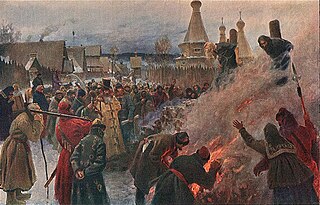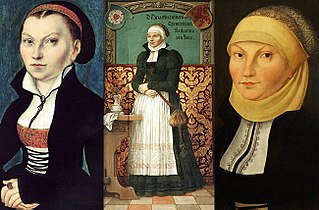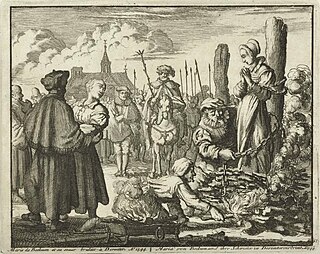
Death by burning is an execution, murder, or suicide method involving combustion or exposure to extreme heat. It has a long history as a form of public capital punishment, and many societies have employed it as a punishment for and warning against crimes such as treason, heresy, and witchcraft. The best-known execution of this type is burning at the stake, where the condemned is bound to a large wooden stake and a fire lit beneath.

Anne, Princess Royal and Princess of Orange was the second child and eldest daughter of King George II of Great Britain and his consort Caroline of Ansbach. She was the wife of William IV, Prince of Orange, the first hereditary stadtholder of all seven provinces of the Northern Netherlands. She was Regent of the Netherlands from 1751 until her death in 1759, exercising extensive powers on behalf of her son William V. She was known as an Anglophile, due to her English upbringing and family connections, but was unable to convince the Dutch Republic to enter the Seven Years' War on the side of the British. Princess Anne was the second daughter of a British sovereign to hold the title Princess Royal. In the Netherlands she was styled Anna van Hannover.

Gaietà Ripoll i Pla was a Catalan schoolmaster who was executed for teaching deist principles. He is considered to be the last known victim of the Spanish Inquisition, although technically the Inquisition no longer existed at that time and it was the Junta de Fe of Valencia, until having him hanged by the civil authority.

The status of Women in the Protestant Reformation was deeply influenced by Bible study, as the Reformation promoted literacy and Bible study in order to study God's will in what a society should look like. This influenced women's lives in both positive and negative ways, depending on what scripture and passages of the Bible were studied and promoted. The ideal of Bible study for commoners improved women's literacy and education, and many women became known for their interest and involvement in public debate during the Reformation. In parallel, however, their voices were often suppressed because of the edict of the Bible that women were to be silent. The abolition of the female convents resulted in the role of wife and mother becoming the only remaining ideal for a woman.
Women have played a leading role in active warfare. The following is a list of prominent women in war and their exploits from about 1500 up to about 1699.

Elisabeth Carolina van Dorp was a Dutch lawyer, economist, parliamentarian and feminist.

The European wars of religion were a series of wars waged in Europe during the 16th, 17th and early 18th centuries. Fought after the Protestant Reformation began in 1517, the wars disrupted the religious and political order in the Catholic countries of Europe, or Christendom. Other motives during the wars involved revolt, territorial ambitions and great power conflicts. By the end of the Thirty Years' War (1618–1648), Catholic France had allied with the Protestant forces against the Catholic Habsburg monarchy. The wars were largely ended by the Peace of Westphalia (1648), which established a new political order that is now known as Westphalian sovereignty.

Maria van Beckum was a Dutch noblewoman and Anabaptist executed for heresy.
Aagt Jafies or Aagt Jansdr was a Dutch arsonist, known as an informant of suspected heresy.

Wendelmoet Claesdochter was a Dutch Lutheran who was executed for heresy by strangulation followed by burning, and is known as the first woman victim to the religious persecutions in the Netherlands during the reign of Emperor Charles V.

Anneke Esaiasdochter, was a Dutch Anabaptist executed as a heretic and at the time regarded as a Protestant martyr.
Aefgen Listincx, or Aeff Pietersdochter, was a Dutch Anabaptist and prophet.

Weyn Ockers, or Weyn Duijf Adriaen Ockersdr, was a Dutch Protestant sentenced to death for heresy after having taken part in the famous Beeldenstorm, the iconoclastic riots, in Amsterdam in 1566.

Maria van Schooten (1555–1573) was a Dutch heroine from the Eighty Years' War. She died from the injuries she received after having participated in the defense during the Siege of Haarlem and was given a public funeral with full military honors. She is believed to have been one of the women led by Kenau Simonsdochter Hasselaer, a legendary heroine who helped defend Haarlem against the Spanish invaders.

Leonor de Cisneros, was a Spanish Protestant who was executed for heresy by the Spanish Inquisition and regarded as a Protestant martyr. Her case belongs amongst the most famed of the Spanish Inquisition.
Marietje Jan de Gortersdochter was a Dutch Anabaptist. She is known in history as a martyr of the Anabaptist faith and the mother of the Anabaptist leader David Joris. She was married to the merchant Joris van Amersfoort. She was executed by decapitation in Delft after banned books had been found among her possessions.
The witch trials in the Netherlands were among the smallest in Europe. The Netherlands are known for having discontinued their witchcraft executions earlier than any other country in Europe. The provinces began to phase out capital punishment for witchcraft beginning in 1593. The last trial in the Northern Netherlands took place in 1610.

Anna Utenhoven was an Anabaptist woman in the Spanish Netherlands who was martyred for her faith. She was buried alive in 1597, and the last person executed for heresy in the Low Countries.
Aagt Germonts (1621-?), was a Dutch woman who was accused of witchcraft.












